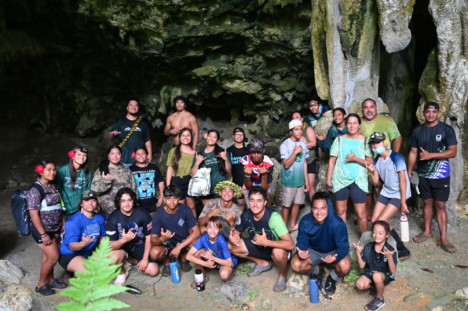He Ēwe Molokaʻi in the Cook Islands – Part 2: Atiu, Enua Manu
Community Contributed
By Keawaiki Madela
Atiu, one of the southern Cook Islands, is a small and close-knit island known as Enua Manu — the land of the birds. It is the third largest of the Cooks, about 28 square kilometers, with a population of just over 400 people. The island is home to five main villages: Teenui, Mapumai, Ngatiarua, Areora and Tengatangi.
Upon arrival, our group was greeted with a warm welcome and introduced to the tradition of pātai. A pātai is a formal village welcome, where the community gathers to offer food, speeches, and songs to honor visitors. We experienced three such welcomes — Teenui Village Pātai, Atiu Enua Village Pātai, and Areora Village Pātai — and at each stop we were fed abundantly.
Tables were filled with fresh fruits, traditional dishes, and every community made sure we left well nourished. Each gathering reflected not only the generosity and pride of the people of Atiu, but also the way food serves as a true expression of aloha and welcome.
That first day also gave us time to explore the island’s coastlines and take in its beautiful, lush landscapes. We visited scenic sites, learned local history, and as the sun set, joined in kupenga — traditional night net fishing.
Wading into the dark waters alongside our hosts, we participated in an experience that felt very similar to our practice of paipai in Hawaiʻi. The catch that night included lobsters, adding to the excitement and making the moment even more memorable.
The next day brought lessons in paiere — the carving of waka, or canoes — led by Uncle Joshua Jim, who shared stories of how men once learned through trial and error to build waka that would float and function for fishing. He explained how their canoes differ from ours, and then invited the boys to carve the manu ihu (prow) and manu hope (stern) of the waka, while the girls picked exotic flowers and explored the ʻāina.
Our adventures continued with a hike to Ana Takitaki cave, home of the endangered kōpeka bird. The trail wound across the rugged makatea, with narrow stone passages once used as traps by warriors. At the cave’s entrance, each of us placed a stone on a growing pile to mark our first time entering. Inside, we listened for the kōpeka — tiny birds that navigate in darkness and rarely appear outside during the day. It was humbling to be in such a sacred place of life and history.
We closed our time on Atiu with community work and laughter, planting orange trees as a gift of continuity. Students remember slipping in the mud, being chased by a pig, and swimming at the harbor to wash off the day. That evening we prepared an umu, an earth oven, and gathered for a final exchange of dance, song, and stories.
This trip made a huge impact on my life. Being in Atiu reminded me of home, and it showed me how special our island is too. I learned so much, and I hope everyone who came will carry these lessons with them.












Don't have a Molokai Dispatch ID?
Sign up is easy. Sign up now
You must login to post a comment.
Lost Password